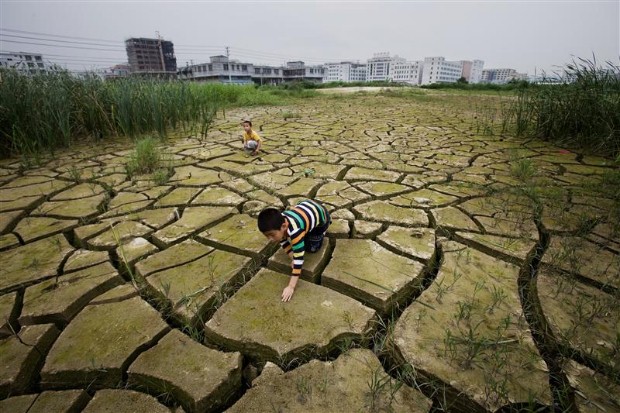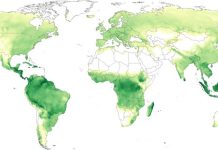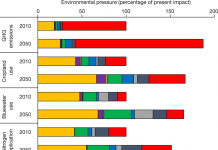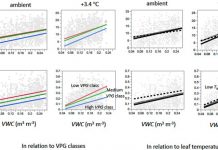【寻找国家尺度的土地可持续发展途径】Lei Gao & Brett A. Bryan. Finding pathways to national-scale land-sector sustainability. Nature 544, 217–222 (13 April 2017) doi:10.1038/nature21694
Abstract
The 17 Sustainable Development Goals (SDGs) and 169 targets under Agenda 2030 of the United Nations1, 2 map a coherent global sustainability ambition at a level of detail general enough to garner consensus amongst nations3. However, achieving the global agenda will depend heavily on successful national-scale implementation4, which requires the development of effective science-driven targets3 tailored to specific national contexts1 and supported by strong national governance. Here we assess the feasibility of achieving multiple SDG targets at the national scale for the Australian land-sector. We scaled targets to three levels of ambition and two timeframes, then quantitatively explored the option space for target achievement under 648 plausible future environmental, socio-economic, technological and policy pathways using the Land-Use Trade-Offs (LUTO) integrated land systems model5, 6. We show that target achievement is very sensitive to global efforts to abate emissions, domestic land-use policy, productivity growth rate, and land-use change adoption behaviour and capacity constraints. Weaker target-setting ambition resulted in higher achievement but poorer sustainability outcomes. Accelerating land-use dynamics after 2030 changed the targets achieved by 2050, warranting a longer-term view and greater flexibility in sustainability implementation. Simultaneous achievement of multiple targets is rare owing to the complexity of sustainability target implementation and the pervasive trade-offs in resource-constrained land systems7, 8, 9. Given that hard choices are needed, the land-sector must first address the essential food/fibre production, biodiversity and land degradation components of sustainability via specific policy pathways. It may also contribute to emissions abatement, water and energy targets by capitalizing on co-benefits. However, achieving targets relevant to the land-sector will also require substantial contributions from other sectors such as clean energy, food systems and water resource management. Nations require globally coordinated, national-scale, comprehensive, integrated, multi-sectoral analyses to support national target-setting that prioritizes efficient and effective sustainability interventions across societies, economies and environments.
【地表和地下水过程在河网N2O排放中的作用】Alessandra Marzadria,1,2, Martha M. Deeb,1, Daniele Toninaa,1, Alberto Bellinc,1, and Jennifer L. Tankb,1. Role of surface and subsurface processes in scaling N2O emissions along riverine networks. PNAS, 2017, doi: 10.1073/pnas.1617454114
Abstract
Riverine environments, such as streams and rivers, have been reported as sources of the potent greenhouse gas nitrous oxide (N2O) to the atmosphere mainly via microbially mediated denitrification. Our limited understanding of the relative roles of the near-surface streambed sediment (hyporheic zone), benthic, and water column zones in controlling N2O production precludes predictions of N2O emissions along riverine networks. Here, we analyze N2O emissions from streams and rivers worldwide of different sizes, morphology, land cover, biomes, and climatic conditions. We show that the primary source of N2O emissions varies with stream and river size and shifts from the hyporheic–benthic zone in headwater streams to the benthic–water column zone in rivers. This analysis reveals that N2O production is bounded between two N2O emission potentials: the upper N2O emission potential results from production within the benthic–hyporheic zone, and the lower N2O emission potential reflects the production within the benthic–water column zone. By understanding the scaling nature of N2O production along riverine networks, our framework facilitates predictions of riverine N2O emissions globally using widely accessible chemical and hydromorphological datasets and thus, quantifies the effect of human activity and natural processes on N2O production.
【全球陆地初级生产总值的历史增长】J. E. Campbell, J. A. Berry, U. Seibt, S. J. Smith, S. A. Montzka, T. Launois, S. Belviso, L. Bopp & M. Laine. Large historical growth in global terrestrial gross primary production. Nature 544, 84–87 (06 April 2017) doi:10.1038/nature22030
Abstract
Growth in terrestrial gross primary production (GPP)—the amount of carbon dioxide that is ‘fixed’ into organic material through the photosynthesis of land plants—may provide a negative feedback for climate change1, 2. It remains uncertain, however, to what extent biogeochemical processes can suppress global GPP growth3. As a consequence, modelling estimates of terrestrial carbon storage, and of feedbacks between the carbon cycle and climate, remain poorly constrained4. Here we present a global, measurement-based estimate of GPP growth during the twentieth century that is based on long-term atmospheric carbonyl sulfide (COS) records, derived from ice-core, firn and ambient air samples5. We interpret these records using a model that simulates changes in COS concentration according to changes in its sources and sinks—including a large sink that is related to GPP. We find that the observation-based COS record is most consistent with simulations of climate and the carbon cycle that assume large GPP growth during the twentieth century (31% ± 5% growth; mean ± 95% confidence interval). Although this COS analysis does not directly constrain models of future GPP growth, it does provide a global-scale benchmark for historical carbon-cycle simulations.
【多全球变化驱动因素对陆地碳储量的影响】Yue K, D.A. Fornara, Yang WQ, Peng Y, Peng CH, Liu ZL, Wu FZ. Influence of multiple global change drivers on terrestrial carbon storage: additive effects are common. Ecology Letters, Volume 20, Issue 5 May 2017 Pages 663–672
Abstract
The interactive effects of multiple global change drivers on terrestrial carbon (C) storage remain poorly understood. Here, we synthesise data from 633 published studies to show how the interactive effects of multiple drivers are generally additive (i.e. not differing from the sum of their individual effects) rather than synergistic or antagonistic. We further show that (1) elevated CO2, warming, N addition, P addition and increased rainfall, all exerted positive individual effects on plant C pools at both single-plant and plant-community levels; (2) plant C pool responses to individual or combined effects of multiple drivers are seldom scale-dependent (i.e. not differing from single-plant to plant-community levels) and (3) soil and microbial biomass C pools are significantly less sensitive than plant C pools to individual or combined effects. We provide a quantitative basis for integrating additive effects of multiple global change drivers into future assessments of the C storage ability of terrestrial ecosystems.








